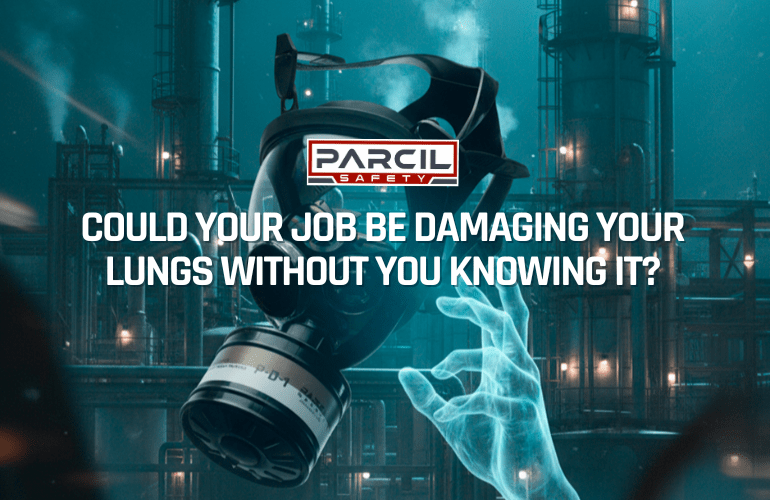Across the United States, blue-collar workers make up the backbone of essential industries. Construction, manufacturing, agriculture, welding, and painting all come with clear risks: falls, burns, or cuts. But there’s one hazard that’s easy to overlook: what you're breathing in every day.
Lung damage from airborne contaminants is one of the most persistent yet hidden threats facing blue-collar workers today. And unlike a visible injury, the effects often take years to show up. By then, it might be too late.
That’s why proper respiratory protection isn’t a nice-to-have. It’s a must. Parcil Safety is committed to making real-world defense gear that’s ready when you need it most.
Get Industrial-Grade Protection Here
Common Jobs, Uncommon Hazards

You don’t have to work in a chemical plant to face serious respiratory risks. Many everyday trades involve toxic vapors, fine particulates, fumes, and biological hazards that can harm your lungs over time.
Hidden Threats by Trade:
- Welders: Exposed to metal fumes and gases like ozone and nitrogen oxide
- Painters and Sprayers: Solvents and VOCs (What are Volatile Compounds?) can lead to long-term respiratory damage
- Construction Workers: Dust from concrete, silica, and asbestos still pose threats
- Farmers: Pesticides and organic dusts (grain, mold, manure) are lung irritants
- Janitorial and Maintenance Crews: Cleaners often contain ammonia or bleach-based chemicals
Even short-term exposure to these contaminants without the right protection can begin to damage lung tissue.
What Does Lung Damage Look Like?

The symptoms of occupational lung disease often start small. A little coughing, shortness of breath, maybe some wheezing. But over time, exposure adds up.
According to the CDC, long-term inhalation of workplace contaminants can cause:
- Chronic bronchitis
- Asthma
- Hypersensitivity pneumonitis
- COPD (Chronic Obstructive Pulmonary Disease)
- Lung cancer
Early symptoms are often ignored or mistaken for allergies or colds. That’s the danger. By the time you realize something’s wrong, permanent damage may have already occurred.
So, What’s in the Air Around You?
Every job site is different. Here are some of the most common airborne hazards blue-collar workers encounter:
- Silica dust from cutting or grinding materials
- Asbestos fibers in older buildings
- Volatile Organic Compounds (VOCs) in paints and adhesives
- Pesticide drift during spraying operations
- Fumes from welding, soldering, or chemical cleaning
These are often odorless or invisible, which makes them even more dangerous.
How Parcil Safety Helps You Breathe Easier

At Parcil Safety, we build respirators designed for real-world threats, not just theoretical ones. Whether you're sanding drywall or spraying industrial coatings, our filters are lab-tested and field-proven.
Top Gear Picks for Common Hazards:
- Welding & Metal Fumes:
- Product: WF-100 Welding Full Face Respirator with O-A-X Cartridge
- Protection: Metal particulates, fumes, and smoke
- Pesticides, Ammonia & Multi-Chemical Exposure:
- Product: IRM-100 Full Face Respirator with P-3-0 Combination Cartridge
- Protection: ABEK agents, ammonia, organic vapors, and fine particles
- Solvent Vapors from Painting or Spraying:
- Product: PD-100 Full Face Respirator
- Protection: Pair with organic vapor cartridges for paint fumes, adhesives, and mists
- Industrial Gas Exposure & Unknown Threats:
- Product: T61 Gas Mask Respirator
- Protection: Versatile defense against a wide range of industrial gases
Get Industrial-Grade Protection Here
Not Sure What You Need? Here’s a Quick Guide
If you’re working around:
- Dust, mold, or debris: N95 or P100 particulate filters
- Paint fumes, adhesives, cleaners: Organic vapor filters (A1 or A2)
- Multiple unknown chemicals: Use multi-gas combo filters like ABEK
Most blue-collar workers don’t think about their lungs until there’s a problem. The goal of this article isn’t to alarm. It’s to empower.
Every breath matters. That’s why Parcil Safety is here. We help you keep showing up, doing the work, and going home safe. Your health is non-negotiable.
When seconds count, your gear should already be ready.
Want more safety insights like this? Read more:
What Kind of Respirator Should I Use in Manufacturing or Fabrication Work?
How Do I Protect My Lungs from Industrial Dust and Chemicals at Work?





















Leave a comment
All comments are moderated before being published.
This site is protected by hCaptcha and the hCaptcha Privacy Policy and Terms of Service apply.